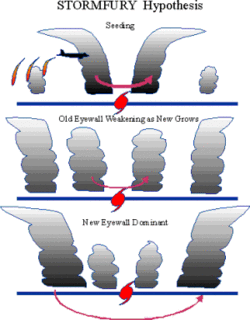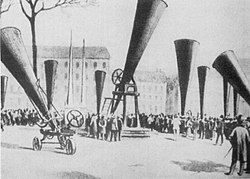Sporadic rantings every now and then....it gets good sometimes... most of the time its just random B.S.
Tuesday, August 30, 2011
Weather control
A tornado in central Oklahoma. Weather control researchers aspire to eliminate or control dangerous types of weather such as this.
Weather control is the act of manipulating or altering certain aspects of the environment to produce desirable changes in weather. Weather control can have the goal of preventing damaging weather, such as hurricanes or tornadoes, from occurring; of causing beneficial weather, such as rainfall in an area experiencing drought; or of provoking damaging weather against an enemy or rival, as a tactic of military or economic warfare. Weather modification in warfare has been banned by the United Nations.
Witches concoct a brew to summon a hailstorm.
In ancient India it is said that yajna or vedic rituals of chanting manthras and offering were performed by rishis to bring sudden bursts of rain fall in rain starved regions. Some American Indians like some Europeans had rituals which they believed could induce rain. The Finnish people, on the other hand, were believed by others to be able to control weather. As a result, Vikings refused to take Finns on their oceangoing raids. Remnants of this superstition lasted into the twentieth century, with some ship crews being reluctant to accept Finnish sailors. The early modern era saw people observe that during battles the firing of cannons and other firearms often initiated precipitation. Magical and religious practices to control the weather are attested in a variety of cultures.
In Greek mythology, Iphigenia was offered as a human sacrifice to appease the wrath of the goddess Artemis, who had becalmed the Achaean fleet at Aulis at the beginning of the Trojan War. In Homer's Odyssey, Aeolus, keeper of the winds, bestowed Odysseus and his crew with a gift of the four winds in a bag. However, the sailors opened the bag while Odysseus slept, looking for booty, and as a result were blown off course by the resulting gale. In ancient Rome, the lapis manalis was a sacred stone kept outside the walls of Rome in a temple of Mars. When Rome suffered from drought, the stone was dragged into the city. The Berwick witches of Scotland were found guilty of using black magic to summon storms to murder King James VI of Scotland by seeking to sink the ship upon which he travelled. Scandinavian witches allegedly claimed to sell the wind in bags or magically confined into wooden staves; they sold the bags to seamen who could release them when becalmed.In various towns of Navarre, prayers petitioned Saint Peter to grant rain in time of drought. If the rain was not forthcoming, the statue of St Peter was removed from the church and tossed into a river.
Perhaps the first example of practical weather control is the lightning rod. In the 1950s, computer scientist John von Neumann, an early theorizer on weather control, surmized that if Earth were to enter another ice age, a preventive solution would be to dump dirt (or spray soot from cropdusting planes) on the surface of the planet's glaciers. He noted that this would significantly change their reflectivity (albedo), and thus increase the solar energy retained by the planet. Such a strategy would require repeated applications, as storms would cover some portion of the soot with new snow until their frequency and range abated. The theoretical efficacy of von Neumann's proposal remains to be examined. Wilhelm Reich performed cloudbusting experiments in the 1950s to 1960s, the results of which are controversial and not widely accepted by mainstream science. Dr Walter Russell wrote of weather control in Atomic Suicide 1956. Jack Toyer in the 1970s built a rainmaker on Palmers Island near Grafton using a solar mirror, electromagnetic static charge, and infra red frequencies of light to induce weather in regional areas within Australia. His work was continued by his successor, Peter Stevens.
In January, 2011, several newspapers and magazines, including the UK's Sunday Times and Arabian Business, reported that scientists backed by the government of Abu Dhabi, the capital of the United Arab Emirates, had created over 50 artificial rainstorms between July and August of 2010 near Al Ain, a city which lies close to the country's border with Oman and is the second-largest city in the Abu Dhabi Emirate. The artificial rainstorms were said to have sometimes caused hail, gales and thunderstorms, baffling local residents. The scientists reportedly used ionizers to create the rainstorms, and although the results are disputed, the large number of times it is recorded to have rained right after the ionizers were switched on during a usually dry season is encouraging to those who support the experiment.
Cloud seeding for rain
Cloud seeding is a common technique to enhance precipitation. Evidence on its safety is strong, but there are still doubts about its effectiveness. Cloud seeding entails spraying small particles (like silver iodide) into the sky in order to trigger cloud formation. The hope is that the water vapor already in the air will condense onto the particles, forming clouds and eventually falling as rain. It is, of course, impossible to generate water through cloud seeding; cloud seeding only works to the extent that there is already water vapor present in the air. The principal goal is just to force precipitation to fall in one area instead of another. Critics generally contend that claimed successes occur in conditions which were going to rain anyway. It is used in a variety of drought-prone countries, including the United States, the People's Republic of China, India, and Russia. In the People's Republic of China there is a perceived dependency upon it in dry regions. In the United States, dry ice or silver iodide may be injected into a cloud by aircraft, or from the ground. In mountainous areas of the United States such as the Rocky Mountains and Sierra Nevada, it has been employed for several decades.
Project Stormfury
Storm prevention
Hail cannons at an international congress on hail shooting held in 1901
Project Stormfury was an attempt to weaken tropical cyclones by flying aircraft into storms and seeding the eyewall with silver iodide. The project was run by the United States Government from 1962 to 1983. A similar project using soot was run in 1958, with inconclusive results.
Various methods have been proposed to reduce the harmful effects of hurricanes. Moshe Alamaro of the Massachusetts Institute of Technology proposed using barges with upward-pointing jet engines to trigger smaller storms to disrupt the progress of an incoming hurricane; critics doubt the jets would be powerful enough to make any noticeable difference.
Alexandre Chorin of the University of California, Berkeley proposed dropping large amounts of environmentally friendly oils on the sea surface to prevent droplet formation.Experiments by Kerry Emanuel of MIT in 2002 suggested that hurricane-force winds would disrupt the oil slick, making it ineffective. Other scientists disputed the factual basis of the theoretical mechanism assumed by this approach. The Florida company Dyn-O-Mat proposes the use of a product it has developed, called Dyn-O-Gel, to reduce the strength of hurricanes. The substance is a polymer in powder form which reportedly has the ability to absorb 1,500 times its own weight in water. The theory is that the polymer is dropped into clouds to remove their moisture and force the storm to use more energy to move the heavier water drops, thus helping to dissipate the storm. When the gel reaches the ocean surface, it is reportedly dissolved. The company has tested the substance on a thunderstorm, but there has not been any scientific consensus established as to its effectiveness.
Hail cannons are used by some farmers in an attempt to ward off hail, but there is no reliable scientific evidence to confirm their effectiveness. Another new anti-hurricane technology is a method for the reduction of tropical cyclones’ destructive force - pumping sea water into and diffusing it in the wind at the bottom of such tropical cyclone in its eye-wall.
Hurricane modification
Various ideas for manipulating hurricanes have been suggested.
One TV show explored various ideas such as:
Using lasers to discharge lightning in storms which are likely to become hurricanes
Pouring liquid nitrogen onto the sea to deprive the hurricane of heat energy.
Creating soot to absorb sunlight and change air temperature and hence convection currents in the outer wall.
Weather control and law
US and Canada agreement
In 1975, the US and Canada entered into an agreement under the auspices of the United Nations for the exchange of information on weather modification activity.
1977 UN Environmental Modification Convention
Environmental Modification Convention
Weather control, particularly hostile weather warfare, was addressed by the "United Nations General Assembly Resolution 31/72, TIAS 9614 Convention on the Prohibition of Military or Any Other Hostile Use of Environmental Modification Techniques" was adopted. The Convention was: Signed in Geneva May 18, 1977; Entered into force October 5, 1978; Ratification by U.S. President December 13, 1979; U.S. ratification deposited at New York January 17, 1980.
US National Oceanic and Atmospheric Administration
In the US, the National Oceanic and Atmospheric Administration regulates weather control projects, under authority of Public Law 205 of the 92nd Congress.
US Legislation
The Space Preservation Act was proposed "to preserve the cooperative, peaceful uses of space for the benefit of all humankind by permanently prohibiting the basing of weapons in space by the United States, and to require the President to take action to adopt and implement a world treaty banning space-based weapons."
2005 U.S. Senate Bill 517 and U.S. House Bill 2995 U.S. Senate Bill 517 and U.S. House Bill 2995 were two bills proposed in 2005 that would have expanded experimental weather modification, to establish a Weather Modification Operations and Research Board, and implemented a national weather modification policy. Neither were made into law. Former Texas State Senator John N. Leedom was the key lobbyist on behalf of the weather modification bills.
2007 U.S. Senate Bill 1807 & U.S. House Bill 3445 Senate Bill 1807 and House Bill 3445, identical bills introduced July 17, 2007, proposed to establish a Weather Mitigation Advisory and Research Board to fund weather modification research
Future aspirations
Climatologists have simulated hurricane control based on selective heating and cooling (or prevention of evaporation). Futurist John Smart has discussed the potential for weather control via space-based solar power networks. One proposal involves the gentle heating via microwave of portions of large hurricanes. Such chaotic systems may be susceptible to "side steering" with a few degrees of increased temperature/pressure at critical points. A sufficient network might keep the largest and most potentially damaging hurricanes from landfall, at the request of host nations. Blizzards, monsoons, and other extreme weather are also potential candidates for space-based amelioration. If large-scale weather control were to become feasible, potential negative implications may include:
Unintended side effects, especially given the chaotic nature of weather development
Damage to existing ecosystems
Health risks to humans
Equipment malfunction or accidents
Non-democratic control or use as a weapon
ELF hot spots causing slightly accelerated ionospheric depletion by solar wind
For the 2008 Olympics, China had 30 airplanes, 4,000 rocket launchers, and 7,000 anti-aircraft guns to stop rain. Each system would shoot various chemicals into any threatening clouds to shrink rain drops before they reach the stadium.
A Project HAARP antenna
Project Stormfury crew
Conspiracy theorists question the possibility of using weather control as a weapon (e.g. via HAARP and/or chemtrails), At a counterterrorism conference in 1997, United States Secretary of Defense William Cohen referred to the writings of futurist Alvin Toffler, specifically regarding concerns about "environmental terrorism" and intentionally caused natural disasters.
See also
High Frequency Active Auroral Research Program (HAARP)
Weather Modification Operations and Research Board
Global warming
Geoengineering
Weather forecasting
Hail cannon
Operation Popeye
Beijing Weather Modification Office
Bernard Eastlund
Project Cumulus
Alberta Hail Project
Chemtrail conspiracy theory
Subscribe to:
Post Comments (Atom)





No comments:
Post a Comment